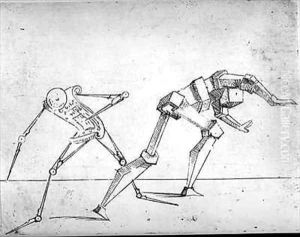Giovanni Battista Bracelli Paintings
Giovanni Battista Bracelli was an Italian engraver and painter who is best known for his work in the Baroque style. He was born in the year 1600, although there is some uncertainty about the exact date and place of his birth. His death is also not precisely documented but is believed to have occurred around 1650.
Bracelli's most famous work is a series of etchings titled 'Bizzarie di varie figure' (Bizarre Figures) published in 1624, which features a collection of prints with human figures composed of a variety of objects, geometric shapes, and abstract patterns. These figures are often depicted in dynamic poses and are considered to be a precursor to the later work of the Cubist and Futurist movements.
The artist's life is shrouded in mystery, and little is known about his training or the early stages of his career. It is assumed that he worked in Florence, Italy, because his prints were published there, and his style suggests an exposure to the Florentine artistic environment of the early 17th century. Bracelli's work indicates that he was influenced by Mannerism, with its elongated forms and intricate compositions, as well as the emerging Baroque style, which was characterized by dramatic expression and movement.
Bracelli's engravings were innovative and unconventional for his time. His work did not gain widespread recognition during his lifetime, and he remained a relatively obscure figure for centuries. It wasn't until the 20th century that art historians began to re-evaluate his contribution to the history of art, particularly in the context of the development of abstract and conceptual art.
Despite the scarcity of biographical information, Giovanni Battista Bracelli remains an intriguing figure in art history. His 'Bizzarie di varie figure' continues to fascinate scholars and art enthusiasts alike with its imaginative creations and its potential influence on the development of modern art movements.



